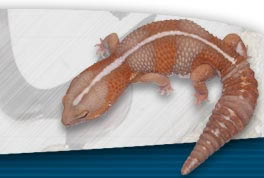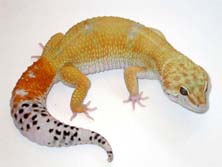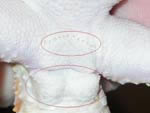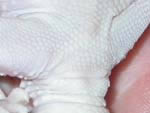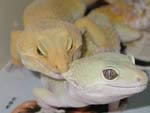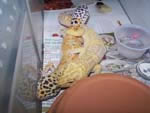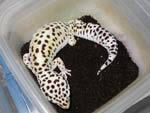

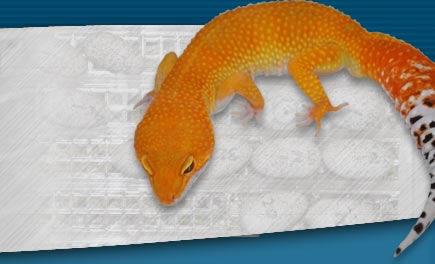

General Information:
Leopard geckos (Eublepharis macularius) or leo for slang originated from the Middle East - Afghanistan, India, and Pakistan area. Adults can obtain lengths of 8 to 12 inches long and weigh 60 to 100+ grams in captivity. Babies are around 3 inches and average 3 grams in weight. Leopard geckos are a terrestrial animal which means they are ground dwellers. Being nocturnal they are most active at night. They are one of the most popular and easiest geckos to keep in captivity. This care sheet will give you the information you need to keep your gecko happy and healthy. With proper care leopard geckos can easily live up to 20 years.Housing:
Leopards are very easy to house. A pair (1 male and 1 female) can live comfortably in a 10 gallon glass aquarium but larger is always better. Most breeders use some kind of rack system. Racks are easier because one can fit more geckos in a given area than with aquariums. Aquariums however are clear giving you the opportunity to view them better and see their natural behaviors. I house my adult leopard geckos in 28 quart Rubbermaid containers and hatchlings in 6 quart tubs. Never keep an animal in cramped quarters. This can cause stress and lead to other health issues.Substrate - The best substrate to use is paper, newspaper, paper towel, slate or tile. I suggest not using sand at all as the gecko may become impacted. Impaction is when the gecko ingests sand which can build up and block the intestine. This is usually in an attempt to get calcium (see below for supplementation). My animals are all kept on paper or paper towel just for the impaction reason. If you’re looking for a more naturalistic look and have to use sand make sure it is as fine as possible. Zoo Meds Repti-sand or Jurassic sand is suitable. Another option is to go with slate or tile. Don’t ever use aquarium gravel, walnut shells or calcium sand. These substrates can be fatal if caught in the gecko’s digestive system. Never use cedar or pine shavings. These are toxic to reptiles.
Hides - In order for the gecko to feel secure in its enclosure provide several hiding places. These can be as simple as inverted plant saucer pans, plants, wood etc. It’s a good idea to put a hide on both the warm end and cool end (discussed in heat section below) of the cage. This will allow them to hide and feel comfortable on both ends of the cage. Along with a dry “dark” hide they need a humid container. The most popular is using a throw away container such as a glad or Tupperware container. Cut a hole in the lid and fill it with moist peat moss, sphagnum moss, forest bed (Coconut fiber) or paper towel. This will provide enough humidity to allow the gecko to shed properly.
Heat and Light - Provide a hot spot of 88 to 90 degrees fahrenheit on the warm end with the cool side of the cage in the mid 70’s. It is very important to provide a temperature gradient for the animal. This is basically having a warm end and a cool end that will allow the animal to regulate its own body temperature. There are several different ways to provide proper heat. One is using under tank heating. This is a strip of heat tape or an under tank heat mat that runs under the cage. This is probably the best heat as it is direct belly heat. Another way is to provide a heat lamp with a 40 or 60 watt light bulb. This will give off heat and light. Because leopard geckos are nocturnal there is no need for special UVB lighting. The heat source will need to be somehow regulated. This can be achieved by using a rheostat or dimmer switch allowing you to adjust the temperature. Make sure to never overheat your geckos. Excessive heat even for a short period of time can and will most likely be fatal.
Quarantine - Quarantining new animals is very important and should be practiced by everyone. This is placing new animals separate from established colonies to make sure they are healthy. They should be in a separate room using their own items that are not shared with the established animals. This period should last anywhere from 30 to 90 days. Take care of the quarantined animals last and wash your hands thoroughly afterwards. If there happens to be a problem with your quarantined animals it’s easier to treat them than it is your entire collection.
Handling - When holding any animal it’s best to take it slow. When you first acquire a new animal don’t hold them for several weeks to several months depending on the individual. This will allow them to adjust to their new environment. Once they have calmed down gently hold the gecko by letting it walk across your hand as it is inside the cage. Once the gecko is familiar with you, you can take it out and hold it. Remember that too much handling too fast or too rough of handling can cause stress on the animal. Another thing to remember is to never grab the tail! If threatened, the tail will detach. Many reptiles are capable of this defense mechanism. It will grow back but will look nothing like the original.
Food & Water:
Leopard geckos are insectivores and the most common items used in captivity are crickets, mealworms, superworms, silkworms and small cockroaches as a staple diet. The occasional pinkie mouse (only a few days old) and waxworms can be given as a treat. Pinkie mice should only be given to full grown adults and are excellent for breeding females. Not all individuals will eat them but the majority prefer them live. Feed waxworms sparingly as they can become very addictive to geckos and not as healthy because they are very fattening. Only feed as much as the gecko will consume in a given feeding. Depending on the size of the gecko this can be anywhere from 4 to 8 crickets. Left over prey running in the cage can cause stress and the gecko might get nibbled on by hungry insects. Babies should be fed everyday with adults being fed every other day. If you’re feeding mealworms, superworms or anything else that can be contained in a dish they can be left with the animal at all times without harm. The gecko will only eat what it wants. As a general rule the prey item should be no larger than half the width of the geckos head to prevent choking.Gutloading - Make sure to gutload all food items for 24 hours prior to feeding. Gutloading is feeding very nutritious, high quality foods to prey prior to feeding to your animals. These can include but not limited to fruits, vegetables and grains. There are also many commercially available products that are in powder form. I make and use Pro Gutload for all my feeders. Gutloading will ensure a healthier insect and in the long run a healthier gecko. Remember your geckos are what they eat.
Supplementation - Calcium and vitamins are essential for reptiles. There are many different products on the market but I use and recommend Rep Cal calcium and herptivite as my calcium/vitamin supplements. The most common way of offering this to them is by dusting the prey just before feeding. This can be done with the “shake and bake” method. Using a plastic bag or some type of container, add a small amount of calcium/vitamin supplement. Add a few food items and gently shake the bag until they are covered in calcium. When dusting crickets make sure to feed them right away because they clean the calcium off. They are now ready for your geckos to eat. If you are dish feeding mealworms or superworms you can add a small amount of calcium to the dish.
Babies should get dusted prey items at least 4 times a week but preferably at every feeding and adults 2 to 3 times per week. Egg laying females should also get dusted food items at every feeding as they are absorbing large amounts of calcium to produce the egg shells. For all ages dust with calcium that contains vitamin D3 along with the vitamin supplement once a week. I also provide a dish of pure calcium (that contains no vitamin D3) that is left in the gecko cage 24/7. If the gecko wants more calcium they can lick what they want. You may not see your geckos doing this but believe me they are. Lack of supplementation will eventually lead to MBD (Metabolic bone disease) and can cause serious problems with reptiles that can lead to death. Some symptoms include very weak and lethargic animals that will display soft limbs and bones.
Water - Offer a dish of fresh water at all times. I use a 2 ounce or 4 ounce portion cup for my babies and adults. Keeping the water fresh is very important so it should be changed regularly. Water that is stagnant is a breeding ground for bacteria and can cause illness.
Maintenance:
Cleanliness is an absolute must especially when keeping several geckos. The cleaner the cages are the less chance there is of having diseases spread. So this should be done on a regular basis. If you’re using paper or paper towel change it every week or sooner if needed. Change water dishes and give fresh water. Each month you should deep clean everything including water dishes, hides, the cage and anything else that may be in it. Chlorhexidine solution is excellent for cleaning and disinfecting everything.Breeding:
Leopard geckos are one of the easiest geckos to breed. However before you attempt breeding keep in mind the amount of time, space and resources needed to maintain the breeders and babies. What will you do with the babies if they don’t sell right away? Can you still house and take care of them? These are just a few things to consider before attempting breeding. Most people fail to realize this until they have babies.With that being said your breeders need to be ready. Make sure they are full grown adults, healthy and at a good weight. I recommend males a minimum of 8 months old and 45 grams and females being a minimum of 1 year old and 50 grams. Although those are the minimums I prefer my females to be no less than 60 grams as it will be easier on them. If your female can be around 2 years old that would be even better for her.
Sexing - Before you can start breeding you’ll need a sexually matured pair. The good news is that leopard geckos are easy to sex. There are a few different methods to do this. The easiest way is to look at the under side of the gecko. The male will have two pronounced hemipenal bulges behind the vent on the tail side. You can also look for pre-anal pores that will be in a "V" shape just above the vent between the hind legs. Females will not have the hemipenal bulges but may have pre-anal pits rather than enlarged pores. If a female is obese she may appear to have bulges but it’s just fat. If you are raising them from a hatchling you can easily sex them (and know for sure) when they are 20+ grams and around 3 to 4 months old. Another way to tell is just by looking at them. Males are heavy bodied, have thicker necks with their heads being broader than a female.
Breeding - Some breeders give a brief cool down period others don’t. Either way works so it’s just what your preference is. Personally I don’t cool mine. If you do cool them stop feeding a week prior to a cool down. Gradually lower the temperature until it is 70 to 75 degrees fahrenheit as a high. Do this for about 4 weeks then gradually raise the temperatures back to normal. Once they are warmed up offer the pair as much food as they’ll eat so they can gain back the weight they lost during the cool down. After a few weeks, put the male with the female. The geckos may mate right away or it might take a little time. Leave the male with the female for several days and then take him out. You may need to do this several times until you have a successful mating. If you don’t cool them just place the male with the desired females and use the same method as above. It also doesn’t matter if you place the male with the female or visa versa. Both ways will have the same result.
When you place the pair together the male will be aggressive toward the female. He will start biting her and if she is not receptive she will bite back. It may appear as if they are fighting but this is normal behavior. The male will also shake the tip of his tail very quickly. This can be loud at times but again it’s normal behavior and nothing to worry about.
Eggs - Up to 4 weeks after a successful mating the female will lay her first clutch of eggs. Each clutch will consist of 1 to 2 white oval eggs. Leopard geckos have been known to easily lay 8 clutches a year with each clutch being laid in 2 to 4 week intervals. Make sure to provide a suitable container for the female to lay her eggs in. This is basically the humid hide filled with moist but not saturated bed-a-beast.
Incubation - After being laid the eggs need to be removed and placed in an incubator. Leopard gecko eggs are temperature sexed dependent. This means that you can decide what sex baby you want just by incubating at a certain temperature. The text below shows the results with the given temperatures.
Female = 80 degrees fahrenheit
50% mix of both sexes = 85 degrees fahrenheit
Male = 90 degrees fahrenheitThe eggs will hatch in 30 to 105 days. Males generally hatch faster because of the higher temperatures. Females take longer because of the cooler temperatures. On average incubation for females lasts around 60 days and males around 35 days. For detailed instructions on incubating leopard gecko eggs visit my “leopard gecko incubation” page.
Color morphs - One thing that makes leopard geckos so popular with keepers and breeders alike is the vast amount of colors available. This has happened over several years and generations of breeding. Some of these morphs include tangerine, carrot-tail, tremper albino, bell albino, las vegas (rainwater) albino, stripe, reverse stripe, red stripe, jungle, giant, APTOR, RAPTOR, mack snow, line bred snow, patternless, enigma, eclipse, and blizzards just to name a few. All these morphs plus many others have been crossed with one another creating so many different variations. They all have their own unique look making the leopard gecko one of the most majestic species in captivity.
Conclusion:
Leopard geckos have become one of the most popular geckos in the world and have won the hearts of thousands of people. From the novice keeper to the experienced breeder they create joy and excitement. As time goes on they are just gaining in popularity and will continue to be one of the most kept reptiles in captivity. I hope this care sheet has given you a good idea of what leopard geckos are about and I hope you take as much pride in keeping these creatures as I do.Recommended Reading:
The Herpetoculture of Leopard Geckos by Philippe de Vosjoli, Ron Tremper and Roger Klingenberg.

